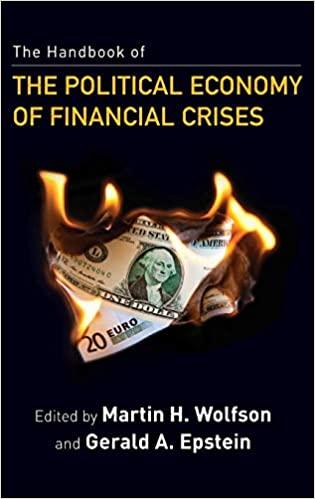Question
Multiple Choice: Choose the best answer. Please Answer all Money center banks rely more heavily on wholesale and borrowed funds as sources of liability funding
- Multiple Choice: Choose the best answer. Please Answer all
- Money center banks rely more heavily on wholesale and borrowed funds as sources of liability funding than do community banks.
- True
- False
- Commercial paper is an alternative (competitive product) for large established companies that otherwise would need a business loan from a commercial bank.
- True
- False
- There is only one regulatory agency for commercial banks in the U.S..
- True
- False
4. Customer deposits are classified on a DI's (depository banks) balance sheet as
a. assets, because the DI uses deposit funds to earn profits.
b. liabilities, because the DI uses deposits as a source of funds.
c. assets, because customers view deposits as assets.
d. liabilities, because the DI must meet reserve requirements on customer deposits.
e. liabilities, because DIs are required to serve depositors.
- Interstate banking barriers in the U.S. deteriorated in part because of the decisions to deal with the failing thrift industry by allowing acquiring firms to cross state lines.
- True
- False
- U.S. banking offices abroad normally are permitted by the Federal Reserve System to engage in activities that are allowed in the foreign country even when such activities are not permitted in the U.S.
- True
- False
- Securities firms specialize in
- purchase, sale and brokerage of existing securities (retail side).
- originating, underwriting, and distributing issues of new securities (commercial side), and merger and acquisitions.
- None of the above.
- Niche (what makes them different) for Credit Unions in the Financial Intermediaries industry is:
a. Nice buildings
b. Customer service
c. non-profit status
d. Convenience
e. Illegal
- Being forced to borrow or sell an asset in a very short period of time is
- Credit Risk
- Interest Rate Risk
- Sovereign Risk
- Liquidity Risk
- Operational Risk
- In general, if the maturity of your assets is equal to the maturity of your liabilities then there is no remaining interest rate risk.
- Yes
- No
- If the maturity of your assets is longer than the maturity of your liabilities you face:
- Reinvestment Rate Risk
- Refinancing Rate Risk
- None of the above
- Which of the following is not an off-balance Sheet item?
- Loan commitments
- Derivatives positions
- Letters of credit
- Contingent assets
- All the above are off-balance sheet items
- Which of the following conflicts of interest have been identified as potential roadblocks to the expansion of banking powers into the financial services area?
- The incentive interest of the salesperson to sell rather than to just provide dispassionate advice.
- Competitive product pricing.
- Timely customer service responses to issues.
- The opportunity to tie lending availability to the use of the investment affiliate products for securities needs.
- Both (a) and (d)
14. Which of the following statements is FALSE?
a. A financial intermediary specializes in the production of information.
b. A financial intermediary reduces its risk exposure by pooling its assets.
c. A financial intermediary benefits society by providing a mechanism for payments.
d. A financial intermediary may act as a broker to bring together funds deficit and funds surplus units.
e. A financial intermediary acts as a lender of last resort.
- Mutual funds often offer multiple share classes which differentiate between different methods of paying brokers for services.
- True
- False
- Sales finance companies compete directly with depository institutions for consumer loans.
- True
- False
- The growth in home equity lines of credit over the last two decades has occurred in part because of the tax deductibility of the interest payments.
- True
- False
- Finance companies generally attract less risky customers than do commercial banks.
- True
- False
19. Which of the following refers to the term "maturity intermediation"?
a. Creation of a secondary market mature enough to withstand volatility.
b. Overcoming constraints to buying assets imposed by large minimum denomination size.
c. Mismatching the maturities of assets and liabilities.
d. Reducing information costs or imperfections between households and corporations.
e. The transfer of wealth from one generation to the next.
20. When a DI makes a shift from an originate-to-hold banking model for loans to an originate-to-sell model, the change is likely to result in
a. increased operating costs.
b. increased interest rate risk.
c. increased liquidity risk.
d. decreased monitoring costs.
e. decreased fee income
Step by Step Solution
There are 3 Steps involved in it
Step: 1

Get Instant Access to Expert-Tailored Solutions
See step-by-step solutions with expert insights and AI powered tools for academic success
Step: 2

Step: 3

Ace Your Homework with AI
Get the answers you need in no time with our AI-driven, step-by-step assistance
Get Started


